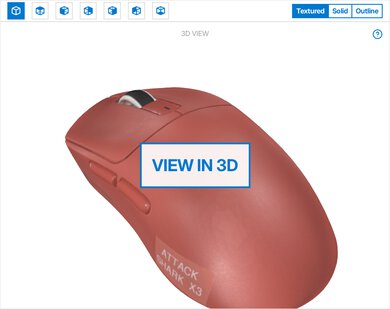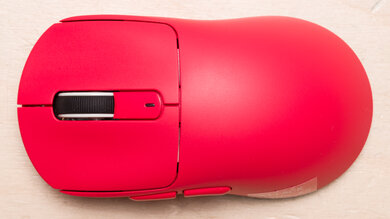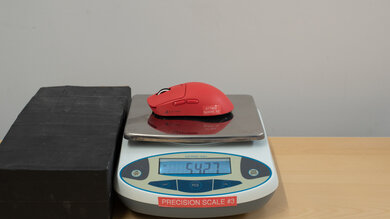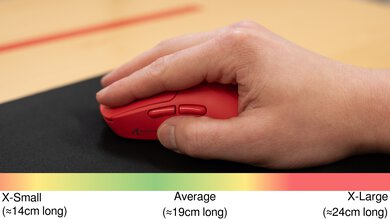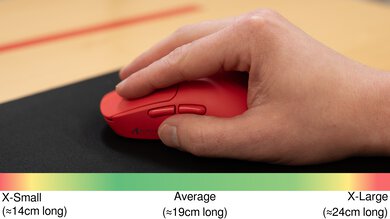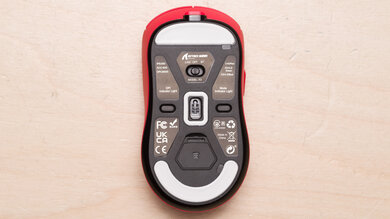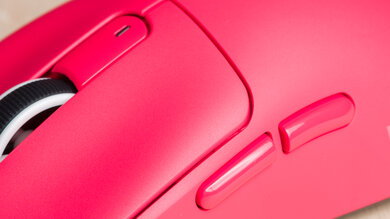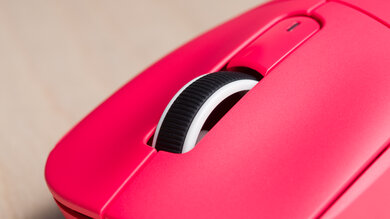The ATTACK SHARK X3 is a budget wireless gaming mouse with a small, symmetrical shape and a centered hump in the middle of its solid plastic body. It uses a PixArt PAW3395 sensor and a Beken BK3633 MCU. It has a maximum polling rate of 1000Hz, and you can connect it using the included 2.4GHz wireless USB receiver or with Bluetooth.
Our Verdict
The ATTACK SHARK X3 is a decent work mouse, although it's mainly designed for gaming. It has good overall build quality and an accommodating, if somewhat small, symmetrical shape. You can remap its buttons using the companion software and connect to up to three devices simultaneously using Bluetooth and its included wireless USB receiver. That said, it lacks some useful productivity features like L/R scroll wheel inputs and a free-scrolling mode.
-
Good build quality.
-
Fantastic wireless versatility with both Bluetooth and 2.4GHz USB connectivity.
-
Scroll wheel lacks free scrolling and L/R tilt inputs.
The ATTACK SHARK X3 is a very good FPS gaming mouse for casual play. It's lightweight and has an accommodating symmetrical shape, excellent mouse feet, and good build quality that help it feel great in your hand. That said, while its sensor performance is great, its click latency is only decent and isn't suitable for competitive gaming at the highest caliber without any disadvantage.
-
Good build quality.
-
Lightweight.
-
Great overall sensor performance.
-
Slightly high and inconsistent click latency is suitable for casual gaming but too high for competitive gaming.
The ATTACK SHARK X3 is okay for MMO or MOBA gaming. While it doesn't have nearly as many side buttons as dedicated MMO mice, you can remap the buttons it does have with the companion software quite easily. It has good build quality and an accommodating, if a little small, symmetrical shape. While its sensor performs well, its click latency is only decent and could be too high depending on your competitive level.
-
Good build quality.
-
Great overall sensor performance.
-
Fewer additional buttons than dedicated MMO mice.
-
Slightly high and inconsistent click latency is suitable for casual gaming but too high for competitive gaming.
The ATTACK SHARK X3 has great raw performance overall. It has excellent sensor latency and tracks your movements accurately for the most part. Still, its sensor performance isn't quite as good as other mice with the same sensor, as it exhibits a slightly higher degree of speed-related accuracy variation (SRAV) than expected. Also, while decent, its click latency is fairly high and somewhat inconsistent, making it best suited for casual titles.
-
Excellent sensor latency.
-
Slightly high and inconsistent click latency is suitable for casual gaming but too high for competitive gaming.
-
Slightly higher than expected SRAV.
- 7.0 Work
- 8.2 Video Games (FPS)
- 6.9 Video Games (MMO)
- 8.4 Raw Performance
Changelog
- Updated May 26, 2025: Review published.
- Updated May 21, 2025: Early access published.
- Updated Apr 29, 2025: Our testers have started testing this product.
- Updated Apr 01, 2025: The product has arrived in our lab, and our testers will start evaluating it soon.
- Updated Mar 12, 2025: We've purchased the product and are waiting for it to arrive in our lab.
Differences Between Sizes And Variants
The ATTACK SHARK X3 is available in White, Black, Red, Purple, Orange, and Berry Red color variants. You can also purchase it with adhesive grip tape at an additional cost. We bought and tested the Red colorway. See our unit's label.
Compared To Other Mice
The ATTACK SHARK X3 is a budget wireless gaming mouse with a symmetrical shape and a solid plastic body. It's a smaller mouse whose shape is closely reminiscent of the Razer Viper Mini, so it's best suited for claw or palm grip for smaller hands, or fingertip grip for medium to large hands.
Unfortunately, it's a decidedly worse performer than other budget mice with the same or similar specifications, like the MCHOSE L7 Pro and the VGN Dragonfly F1 Pro Max. Its biggest shortcoming is its click latency, which is significantly worse than those options. Still, it's absolutely suitable for casual titles and non-competitive gaming, and it's usually more readily available from major retailers and goes on sale more frequently than those mice.
For more recommendations, see our picks for the best FPS mouse, the best claw grip mouse, and the best cheap and budget gaming mouse.
The Logitech G305 LIGHTSPEED and the ATTACK SHARK X3 are symmetrical wireless gaming mice. The Logitech has an egg-like shape with sides that taper in and a rounder rear end, whereas the the ATTACK SHARK has flatter sides and a hump with a more gradual slope. The Logitech has better raw performance, with better click latency and a more accurate sensor, while the ATTACK SHARK is significantly lighter and has better mouse feet. It also uses an internal rechargeable battery and supports Bluetooth, while the Logitech only connects to one device at a time with a USB wireless receiver and is powered by a disposable AA battery.
The VGN Dragonfly F1 Pro Max and the ATTACK SHARK X3 are budget gaming mice. They have similar, small symmetrical shapes, but the VGN is slightly lower and flatter, while the ATTACK SHARK is slightly taller and rounder. The VGN is a better all-around performer than the ATTACK SHARK, with better click latency and sensor performance. It also has better build quality with a more solid assembly.
The MCHOSE L7 Pro is a better gaming mouse overall than the ATTACK SHARK X3. It's lighter, has better build quality, and has better overall performance than the ATTACK SHARK. That said, the ATTACK SHARK has better mouse feet than the MCHOSE.
The Keychron M3 Mini and the ATTACK SHARK X3 are lightweight budget gaming mice. They have very similar symmetrical shapes, but the ATTACK SHARK is marginally lighter, albeit with slightly worse build quality. The Keychron, however, delivers better performance, with much lower click latency and a more accurate sensor implementation.
Test Results
The ATTACK SHARK X3 has generic styling that resembles many other modern gaming mice on the market. It has a rounded shape with a matte plastic finish and glossy accents on the side buttons and below the scroll wheel. It doesn't have any RGB lighting, but there's a status light on top that displays battery life and your CPI setting.
We bought and tested the Red colorway, but it's available in several different color options. For more info, see the Differences Between Variants section.
Note that the color in the 3D model is quite desaturated compared to how the mouse looks in reality. The photos of the mouse throughout the review are more representative of its actual color.
This mouse has an internal compartment on its underside to store its USB receiver, so it doesn't get lost in transit.
The ATTACK SHARK X3 has good build quality on the whole. It's made of solid plastic with a matte finish that feels nice in the hand. While it feels generally well put-together, there are some details where it falls short. Namely, there are panel gaps between the main click buttons and the body that likely contribute to noticeable side-to-side wobble. There's also some rattling if you shake the mouse or use it aggressively, and you can hear some creaking if you squeeze the mouse. These issues are noticeable during normal use if you grip the mouse quite tightly or use it aggressively.
This mouse has a fairly small symmetrical shape, similar to the popular Razer Viper Mini. Its centered hump and flat sides accommodate most hand sizes and grip types, but it's best suited for palm and claw grips if you have medium or smaller hands, or a fingertip grip if you have larger hands.
ATTACK SHARK advertises this mouse has a battery life of up to 200 hours, with a charging time of 2-3 hours. While not specified, this estimate is likely using Bluetooth.
If you have this mouse and want to share your experience with the battery life, leave a comment below.
This mouse comes with a lightweight paracord-like cable. It glides smoothly across desks without excessive drag. That said, it retains some minor kinks from its packaging.
This mouse's click latency performance is satisfactory for playing casual titles or non-competitive games. It's a bit too high and inconsistent for playing fast-paced shooters at a competitive level. Its minimum debounce setting of 4 ms likely contributes to its higher click latency. We tested it at its maximum polling rate of 1000Hz wired and wirelessly, and 125Hz over Bluetooth.
If you're looking for a mouse with better click latency, check out the MCHOSE L7 Pro.
This mouse's sensor tracks your movements well overall, but it exhibits slightly higher speed-related accuracy variation than other mice with the same sensor. It's only likely an issue if you play demanding, fast-paced FPS titles at a competitive level.
The ATTACK SHARK X3 mouse has excellent sensor latency performance that's suitable for gaming in any genre.
The above results are using a wireless polling rate of 1000Hz with motion sync turned off.
This mouse's polling rate options are 125Hz, 250Hz, 500Hz, and 1000Hz with the 2.4GHz receiver, and while plugged in. It's limited to a 125Hz polling rate over Bluetooth.
The companion software lets you adjust additional sensor settings, including Motion Sync. For more details, see the Configuration Software section.
While the scroll wheel is quiet, the main clicks and side buttons are on the louder side.
The ATTACK SHARK X3's companion software is basic and easy to use. With it, you can adjust essential parameters like CPI, polling rate, lift-off distance, power management, and macro creation. You can create profiles in the application, but you can't assign a profile switching button on the mouse and can only switch profiles by going into the software.



